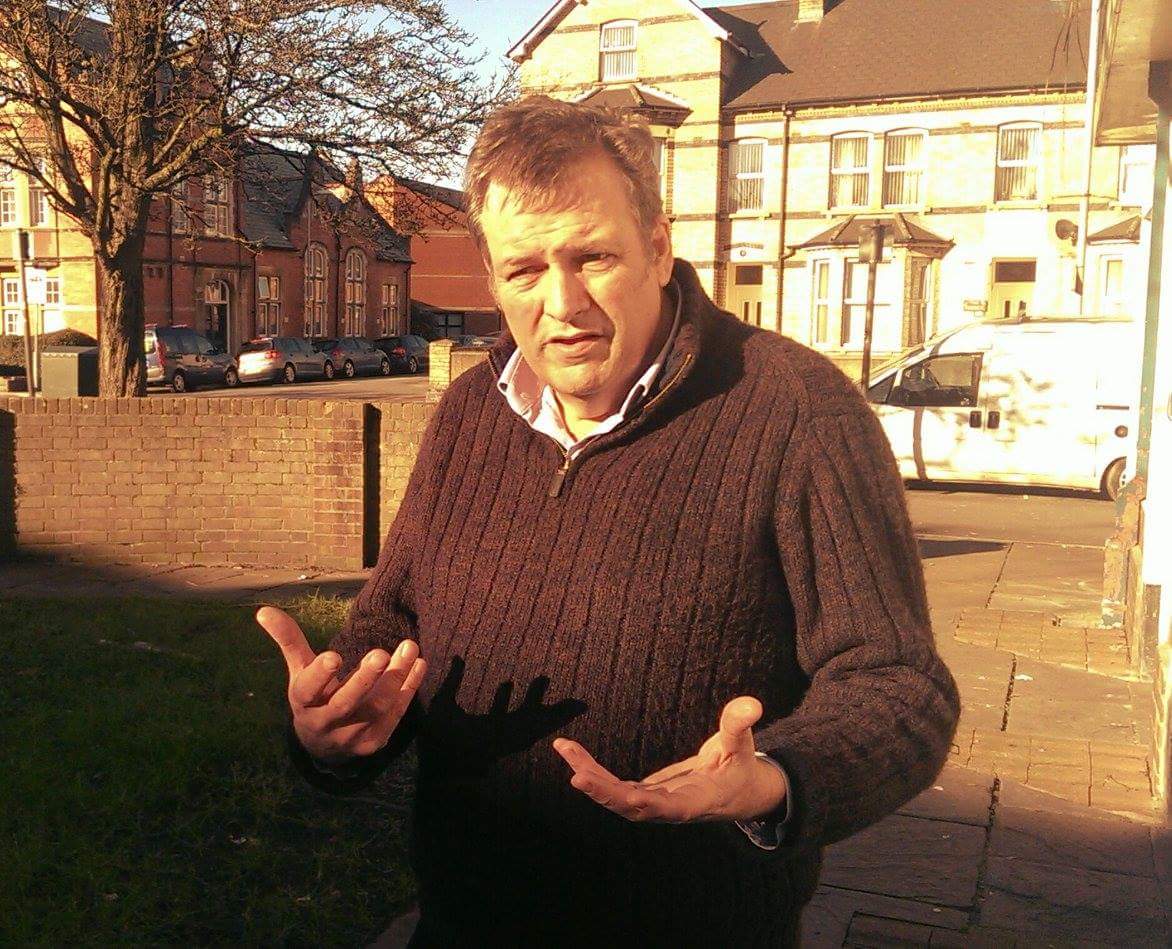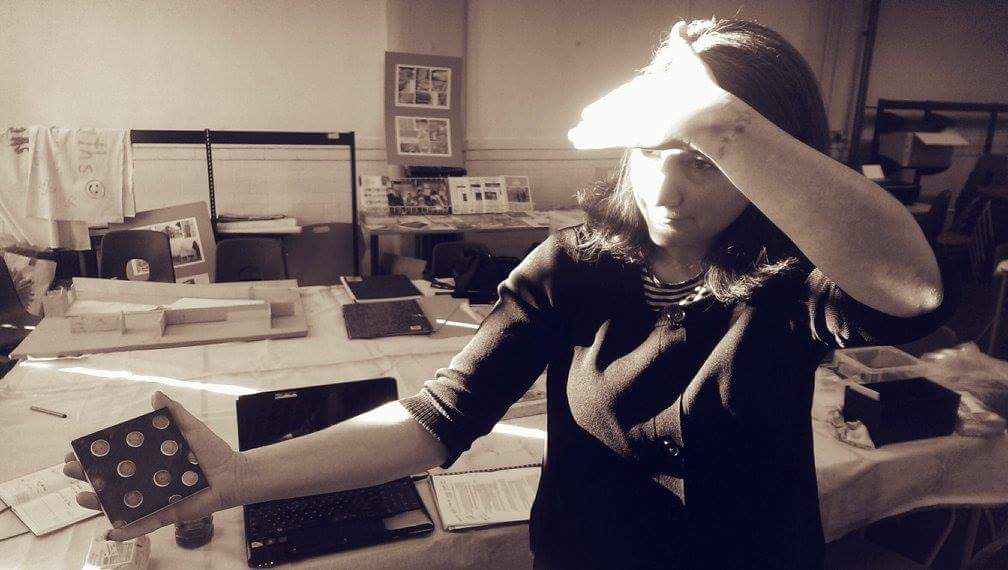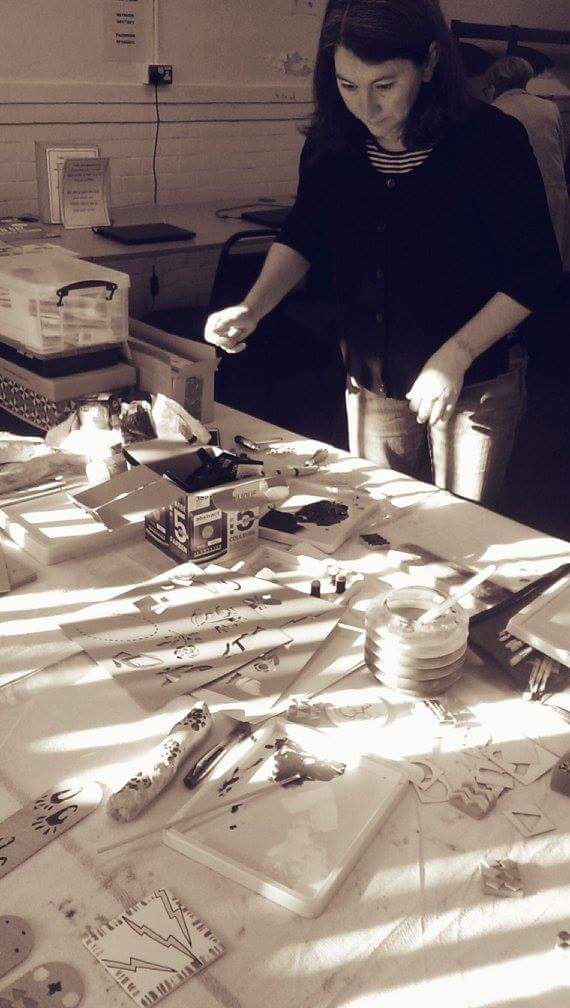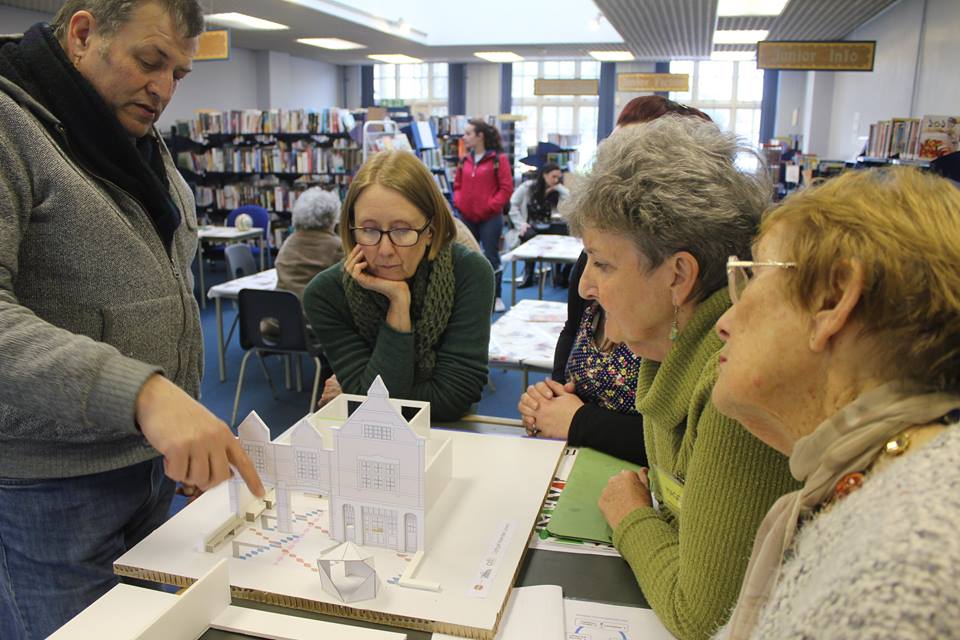As part of our commitment to sharing the experience of the Finding Maindee project we try to give voice to some of the tensions and difficult situations which arise from the projects we are involved in.
Huw Meredydd Owen Writes About his Maindee Experience
In this article, we consider the experience of being involved in two externally-funded programmes. Though we could not do large amounts of our work without money from our funders, we also want to explain the impact of external demands on the 'socially-engaged' work of not just our volunteers and artists, but also on other professionals. In this article Huw Meredydd Owen [pictured below] reflects on his experience between 2014 and 2016 of working with Maindee Unlimited as lead creative on the Library and Triangle Project.

It is also worth pointing out that Huw and his wider team will not be bidding for the commission to complete the design work at the library that we are currently advertising with Addo (deadline 23 April 2017). In this respect, we hope that this account will be of interest to anybody applying for the commission.
Huw's involvement with Maindee
Huw and his wider team worked with us on the initial proposals put forward to Arts Council of Wales (ACW) for Ideas: People: Places programme (IPP) and then won the job to develop proposals for the Big Lottery Community Asset Transfer (CAT2) programme. Having been involved in both CAT2 and IPP Huw’s experience brings further clarity to our recent realisation that these two programmes are at opposite ends of the 'community spaces' spectrum: this is to say whilst CAT2 always wanted certainty in terms of what community assets can generate financially, IPP has always been prepared to use the arts to explore meaning and ambiguity [what we would call deductive as opposed to inductive]. As such, this links to a feeling that 2017 is a good time to be involved in something exploratory like IPP, as fulfilling the outcomes-led CAT2 approach would have put lots of pressure on what is still a young movement in Maindee.
We asked Huw 4 questions and are delighted to have received such long and informative responses.
Q1. What attracted V&O to the commission when advertised in the autumn 2015? It would be good here to explore the second stage of the project rather than the work you initially did to prepare for the CAT2 Stage 1 application?
We were interested in the project at Maindee as it was something that we had worked on in detail for a period of over a year [e.g. starting in 2014], and had been inspired by the IPP approach to see worth in people’s reactions to their environment, whether physical, geographical, spatial, creative or personal - what you might call, in any combination, ‘community’. The IPP process was originally aimed at using creative analysis as a catalyst for thoughts and actions towards regeneration, and our approach, based on spatial reaction and an expression of what that caused, we felt were ideal. The level of engagement would be settled as the process would get under way – it depends on the commissioning body to get a process going as they will eventually be there for the project becoming its movers and shakers or at the very least, backers.
In these days of endless appointment competitions, you come to expect having to reapply for different stages of a project, and it was the case here. Even though you try and get the applicant off the hook at the initial interview, they are, usually at that stage, under the guidance of a ‘specialist’ of some kind who insists that there is no alternative (which is rarely true). So we were very glad that we had been successful in our second competitive process in the project (the first was for the IPP application). We hoped that this meant that MU saw that what we were proposing made sense and was a principle that they too wanted to follow.
This second stage was focused much more entirely on the Library, with the Triangle site - a remnant of the spatial arts approach that we had initially proposed, still tagged on. Stage 1 had been very much about scoping and seeing what was logically connected and deliverable as objectives. That is where the narrow focus of an architect sits very well with the broader view of an artist and why Pandora [pictured below] and I make a good team. Mike Greenwood (architect in Maindee), had local knowledge, as well as Henri Lucas (landscape architect) who had worked with MU before.

One of the points that we did make at the interview was that time was a very pressing issue, with hardly enough to get the finalised scheme in and thorough planning; given that there were complications in terms of Highways [the original plan was to create a better crossing over Chepstow Road at the library]. We, however, we're firmly of the belief that our principles of pursuing a strategy of the wider impact were seen as being important, and maybe, in the event, the sheer mechanics of getting the CAT2 application up and running [for May 2016] had sapped MU’s ability to follow another more explorative process.
The engagement process was not practicable in such a short period, with the very distinct outcomes that CAT2 were looking for, and the inflexibility of the grant award procedure. MU is a very young organisation to have gone through the process. By the end of Stage 2 there’s no doubt that we were simply seen as an architectural team, there to ensure we got planning, costs, tree preservation orders and a good write up from the fire inspectors, or whatever.
What attracted us was the underlying principles [under the aims of Finding Maindee] that we had established the previous year, and it was disappointing to understand by the end that they were no longer supporting the approach, which now had a largely pragmatic nature, probably unavoidable by that stage. Our interest is the continuing success of an approach such as IPP, as it is more likely to make a difference to regeneration where CAT2, on the other hand, is a fig leaf, very often, to cover the divesting of local authority activities to a charitable counterpart: there are other political solutions that would be more appropriate, given the will to do so.
Q2. During that second commission [late 2015 to May 2016] was the organisation MU ready for the depth of the work that you did?
Maindee Unlimited is an organisation built upon the good track record of its constituent organisations [such as Maindee Festival Association] and a well established range of skills, but in common with many organisations that suddenly find themselves facing a sweeping change in their circumstances, pragmatic choices take precedence as fires are fought and time-sensitive decisions stray from the strategy. CAT2 had the priority [over the existing IPP Finding Maindee] due to the inflexible programme and the very significant amount of work and strategising that was needed in a very short time.
The hope had been that the way in which we had talked about Maindee in the early stages of IPP (April 2014) as we walked around the streets and the sights, had been entrenched and that all the talk of details for CAT2 had been hidden in the lining, a knowledge, that we were, as soon ‘as this thing is over’, going to go back to those early ideas. In other words, as soon as CAT2 funding was secured we would turn our attention to making a creative process that would draw inhabitants, business people, children, old people, cooks, gardeners, footballers, etc. etc. into their natural ‘lieu’, the ‘place’ with which they all identified, but had no boundaries, and few markers.
There’s always a question of whether we could have taken stronger steps to keep the original strategy nearer the top of the agenda, but getting a view on the business case took precedence over any other community engagement over most of the programme, and the impression was given quite strongly that any other actions might be seen as a distraction. Whilst we persevered with community workshops [pictured below] that proved to be quite effective, thanks to Pandora’s skills and experience largely, their reach was limited, as their promotion had not been adequately pursued, again due to the distraction. It could be argued that an older, longer established organisation would have, by that stage in the project (being older and more mature) established a wider network of advocates which might have made it more of a success.

There is no doubt about the commitment of the individuals involved, their enthusiasm and the appreciation that they had of the Library as a core generator of community involvement, it’s just that due to the ‘perfect storm’ that had engulfed them that they had switched focus from
IPP to CAT2, and with it a switch from exploratory process to predefined outcomes, and that this was the key factor rather than skills or scale. IPP depends on the success of the engagement and has a lot less emphasis on proving sound business methods, etc. with all the effort that takes to fulfil. It should, therefore, be suitable for a much wider range of community organisations, as we have in Wales.
Q3. What did you think of the requirements made by the CAT2 process? That is to say the timelines and the detail of the information they required?
It is understandable that large fund givers need to tailor their programmes to suit funding cycles and to consider distribution geographically and in terms of different sectors (which might mean that the next funding round might not look so favourably upon an application that is being prepared for the previous one). It is also understandable that a well established organisation with many applications under their belt would be able to cope better with relatively small adjustments to their core operations than a new organisation might have when simultaneously setting themselves up and answering detailed questions that they are only encountering for the first time.
In our case the selection interview happened in November 2015, with work beginning immediately on the part of our team, picking up where we had left off in the previous Stage 1 application [in 2014]. However, the whole CAT2 application had to be submitted by May 11th and substantial progress was expected by the intermediate meeting in March. Since a planning application takes at least 9 weeks from submission, the time left to explore and incorporate anything that needed to be included in the application had therefore to be submitted by early March and given a slow start after the new year, meant in effect about 7 weeks. This did not mean that there was no time in parallel to the planning process for many other aspects to have been pursued, but it meant being much less fluid in our approach, which rather concentrated the impression of just being an architectural team. We had originally considered a period of about 18 months as being optimum for the gearing up of engagement [such as pictured below in March 2016], and a number of higher profile events with the outcome of a deep knowledgeable affinity with the locality and its community, upon which practical outcomes could be modelled and taken further.

We had also hoped that there might have been a collegiate approach from a cadre of artists all working in the different aspects of the wider project [such as is starting to happen through New Paths], all of whom would have contributed by their presence, their ideas and the multiplier effect of being a group. We were hoping that this was what we would return to after the CAT2 failure.
CAT2 requirements meant too that there was an expectation of very detailed evidence for the proposal, corresponding to a much more commercial tendering process. If IPP (or any successor) is to succeed, then it has to work with such funders and ensure that the concomitant processes interweave, thereby introducing an enhanced benefit and not cancelling each other as has been the case here.
Q4. What would you have done with more time? For example, you explored the idea of working with other artists. How would you have explored the sense of place in Maindee and Chepstow Road? And would this have been better for IPP?
When we first started to look at Maindee in detail in April 2014, we were struck by the momentum carried by identity. People were proud to be known as Maindee people, despite the successive waves of people who had moved to the area over several generations, and the relatively short history of the locality as a densely inhabited neighbourhood - the result of trade and industry in the Newport. There were many layers that needed unpicking - as with most places, but even more so here. This is what drove our interest.
We were anxious to take an approach that would gradually gear up a broadly based engagement across the area, of whatever economic, social or cultural constituency, with a number of publicised events, leading towards a programme of self directed activities and eventually a deep understanding of the locality sufficient to make an action that would be meaningful to the local population, that would make a ‘mark’. This is in line with the sort of approach known roughly as ‘Critical Landscapes’ (explored in Emily Eliza Scott and Kirsten Swenson’s book of the same name - a theme that had been established in MUs one day Regeneration Seminar event, held in June 2014, where the theme was addressed by Mary Clear (Todmorden), Paul Haywood (artist) and Anna Minton (author of “Ground Control: Fear and Happiness in the 21st Century") and myself.
In similar circumstances, different outcomes have been pursued from the very practical Incredible Edible to a ‘pure’ performance/video piece by Francis Alÿs featured in Scott and Swenson’s book “When faith moves mountains”. But also similar to a recent intervention at the Art and Architecture ‘Storefront’ in New York - ‘Paranoia Man in a Rat Fink Room’ made up to look like a seedy cub with an attached DVD shop - as a location for discussions and events. The outcome in this case would have been gauged by its effectiveness as a catalyst, but some practical results were outlined in our very general proposal, ‘A hub, some spokes and a triangle: places for action’ suggesting where a focus might lie, and how different actions might generally coalesce to achieve the ends required, once they had been identified.
Integral to that expectation was a collegiate approach with the other artists involved in the broader scheme, multiplying the creative intensity and ensuring a much more effective spread of ideas. In the event, our work had to be completed about the time that most artists were being approached, and our work, as a result, became even more focussed on the practicalities, whilst the other artists could pursue more exploratory strategies. IPP would benefit from seeing how well this coalescent strategy might be inculcated and nurtured - in similar projects but also generally across the spread of those engaged in regeneration. This was always the problem with calculating the ‘worth’ of public art when tat was seen a decade or two ago as a community development panacea, but turned out to be neither public nor art in the most part.
IPP sets out in its guidance [emphasis added with underlined words]:
"Through Ideas: People: Places we will invest in a small number of exemplary projects that genuinely seek to test new models of regeneration and collaboration through the arts. We want to explore new ways of working, nurture new partnerships, and champion quality in both the design and the execution of projects. Successful projects will, we expect, be those that adopt a thoughtful and creative approach to regeneration – an approach that connects and empowers communities, seeing them as important contributors to the regeneration process."
Amen
Constant Nieuwenhuys (Dutch architect/artist) speaks of his ‘New Babylonians’:
"Without the passivity of tourists, but fully aware of the power they have to act upon the world, to transform it, to recreate it... ‘ with new means ‘ ... Just like the painter, who with a mere handful of colours creates an infinite variety of forms, contrasts and styles, the new Babylonians can endlessly vary their environment, renew and vary it by using their technical implements. This comparison reveals a fundamental difference between the two ways of creating. The painter is a solitary creator who is only confronted by another person’s reaction once the creative act is over. Among the New Babylonians, on the other hand, the creative act is also a social act [emphasis added]; as a direct intervention in the social world, it elicits an immediate response... And it is only much later when the work acquires an undeniable reality, that it will have to confront society.”
A Concluding Commentary
What this blog tries to articulate is that there are more people involved in the relationships (aside from the client, designer, creatives, artists and the community) when we undertake design exercises such as refurbishing Maindee Library. For Maindee we feel like the development of the project - and the library volunteers, artists in Maindee and the trustees behind Maindee Unlimited – are now at the right moment as part of IPP to work on the library space. The story of Huw’s involvement, therefore, illustrates that much of life is about timing and learning from experience.
We thank Huw for the time he has taken to prepare his reflections. Moreover, we are grateful for the honesty expressed and how the detail of this writing shows that professionals - such as creatives, architects and artists - develop a strong understanding of places and bonds to people; something that we all perhaps underestimate at times. In many ways the flow of work by Huw, Pandora, Mike and the rest of the team suffered due to timings and changing circumstances of Maindee Unlimited; principally the busy CAT2 preparations in 2016 broke the momentum and ethos built up in 2014 and early 2015. It may be confusing to some that our thinking in March 2017 seems like a return to the approach of 2014 or early 2015 which Huw wrote about above. However, we have all gained experience from this significant journey and hope this article helps to explain that.
The approach we now take for Maindee library is not just about the amazing success of the volunteers who run the library; or the great creative people that we have worked with; but also about the wider relationships that we have developed in the past 15 months. For example, with Newport City Council as land owners, ACW and our other funders. The demands of the CAT2 application process have been clearly explored above, but it is also worth noting that we have also had pressure put on us by ACW. They have always asked demanding questions of the CAT2 process; for example, they brought in architect Niall Maxwell last summer to review our plans and have now strongly encouraged us to work with Addo on the current design brief.
On reflection, ACW have been proved invaluable as critical of friends and we are confident that we will get something good for Maindee as a place, its library and the people behind it. However, we realise from Huw’s account that to be ‘socially-engaged’ is an experience that sometimes involves loss and disappointment when dreams do not get realised. We do hope that any applicants for the currently advertised commission read this account. It is so important to be 'socially-engaged' as the people behind projects such as this in Maindee are largely doing what they do because they feel strongly about this place, its identity and its future.
Related Links
Website for Huw Meredydd Owen
Maindee commission advertised with Addo (deadline 23/04/17)
Mary Clear and Incredible Edible Todmorden
Artist and academic Paul Haywood
Writer, researcher and reader in architecture Anna Minton
Writing by Scott and Swensson Critical Landscapes
The Situationists and Constant Nieuwenhuys